Spring 2008: The Creative Campus

“The Dance Program is unusual in that it involves work of both the mind and the body simultaneously. It is highly physical, and students are required to think, analyze, and problem-solve through movement and their minds at the same time.” —Dance Program Director Sally Radell
Jon Rou
Arts in Motion
Arts faculty across Emory and Oxford are inspiring students with talent and innovation
Student Poetry
Read some student work from Alloy
Dance
Who’s in charge: Sally Radell, program director
When it began: 1987
How many faculty: 5 full-time; 5 part-time
How many majors: 16 Minors: 14
Subspecialties: Choreography, performance, and teaching; but many students go into other areas such as dance therapy, arts administration, physical therapy, and arts criticism
Most challenging course required for majors: Two rites of passage include Choreography I, which involves making solo studies and involves lots of individual critiquing, and Contemporary Issues in Dance, in which students write and debate grants, hear guest speakers in the profession, build professional contacts, and perform transition exercises on how they will graduate into the field
What’s special about the faculty: All are actively dancing and/or choreographing in the field, which filters into their teaching and all their work with the students
What students love: “Since there are a comparatively small number of majors and minors in dance, they really get to know all the other students and the faculty well. It is a small, closely knit, highly supportive community. Pursuing dance is a scary thing to do, and the students who do it are totally dedicated and passionate about it. This builds wonderful camaraderie.”—Sally Radell
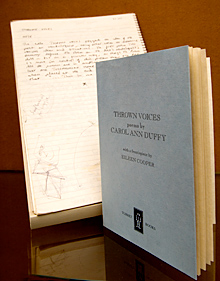
The process of creation was celebrated this spring with Visions and Revisions: an Exhibition of Poems in Process at Woodruff Library. Drawn from the collections of Emory’s Manuscript, Archives, and Rare Book Library, the show charted the trajectory of individual poems by writers including Emory’s Kevin Young and Natasha Trethewey, and British poet and playwright Carol Ann Duffy, whose work, before and after, is shown above.
Kay Hinton
Creative Writing
Who’s in charge: Jim Grimsley, program director
When it began: 1990
How many faculty: 5 full-time; 1 full-time temporary member, plus a number of part-time lecturers
How many majors: 75 Minors: None; the Creative Writing Program offers a minor through the Department of English
Most important course required for majors: In the Advanced Fiction, Poetry, and Playwriting workshops, students are challenged to write more independently at a professional level, and to explore their writing craft more deeply. The key lies in a curriculum that is designed to create a sense of discipline and intellectual focus on a genre of writing; this process transcends any single workshop and involves some level of personal relation and mentorship
Recent faculty achievements: Kevin Young helped mount an exhibit to celebrate the opening of the Danowski collection at the Woodruff Library; Joseph Skibell completed work on a long novel, A Curable Romantic; Natasha Trethewey traveled all over the country in the wake of her 2007 Pulitzer for Native Guard; Jim Grimsley saw his second novel, Dream Boy, premiere as a film at the Berlin International Film Festival and will be following it to major film festivals in Seattle, Chicago, Los Angeles, Milan, and Athens
What students love: “Students revel in the ability to make literature like the books they’ve been reading since they began their schooling. They delight in the opportunity to make something of their own and to be taken seriously as possible writers.”—Jim Grimsley
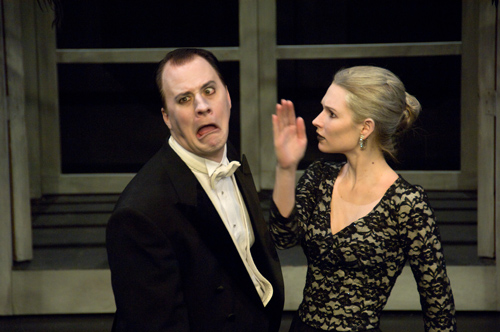
Theater Emory’s Slapping Bernard, written and directed by John Ammerman.
Tony Benner
Theater Studies
Who’s in charge: Leslie Taylor, department chair
When it began: The department, founded in 1983 by James Flannery, celebrates its silver anniversary this year
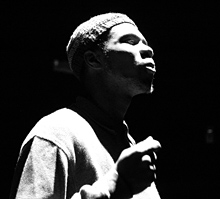
Jacob Willis in the Oxford College production of Exonerated, directed by Professor Clark Lemons.
Ken Anderson
How many faculty: 13
How many majors: 48 Minors: 22
Subspecialties: Acting, design, dramaturgy, directing, playwriting, technical
Most challenging, important, or unusual course required for majors: Aesthetic and Criticism, the senior seminar
What’s special about the faculty: All are professionals in their fields, working both at Theater Emory and other venues in Atlanta, nationally and internationally
What students say: “Theater Emory’s biggest strength is that it incorporates student theater, academic classes, and professional theater. And while the community is small, I feel like there are endless opportunities for me to get involved, learn, and forge my own path at Emory.”—Theater major
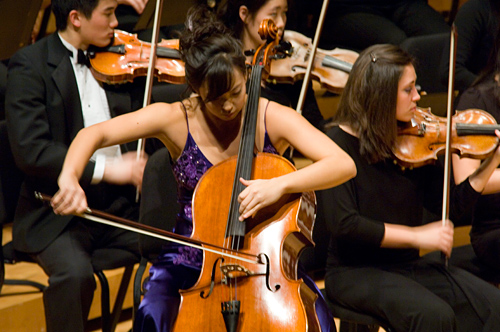
Performing in the Emory Symphony Orchestra.
Jon Rou
Music
Who’s in charge: Stephen Crist, department chair
When it began: 1965
How many faculty: 17 full-time; 5 part-time; nearly 50 artist affiliates; and Coca-Cola Artists in Residence
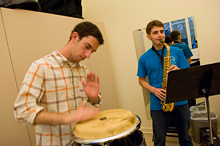
Each year, enrollment in music courses is more than a thousand students—like those rehearsing here.
Jon Rou
How many majors: 135 Minors: 30 to 40
Varied offerings: Western Music History and Literature, Music and Culture, Music Theory and Composition, Performance Studies (private instruction in instruments and voice), 10 active performing ensembles including the University Chorus, Concert Choir, Wind Ensemble, Orchestra, Big Band, Jazz Combos, World Music Ensembles
Most important course required for majors: The four-semester music theory sequence provides students with the tools to understand how music works—the theoretical foundations of Western music, such as scales, modes, harmonic progressions, musical forms
What’s special about the faculty: Proficiency in performance as well as their specialty, whether research or composition. And versatility: the faculty are interested in all kinds of music, and involved in music in multiple ways, as performers, composers, critics
What students love: “The high degree of interaction with the faculty and the camaraderie that develops among students who play together in musical ensembles; they enjoy working together and playing together.”—Stephen Crist
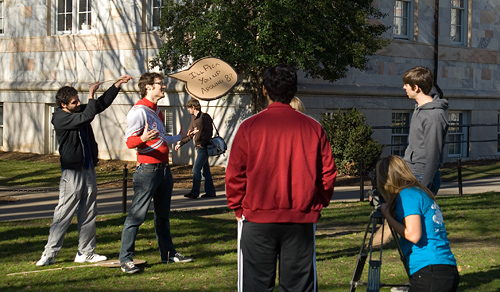
Emory has long garnered respect for its film studies program, with its scholarly focus on history, theory, and criticism. More recently, students have had a chance to try their hand behind the camera. Above, Susan Talbot 08C shoots her first film.
Kay Hinton
Film Studies
Who’s in charge: Matthew Bernstein, chair
When it began: As a program, 22 years ago; as a department, 5
How many faculty: 3 full-time; 1 full-time lecturer; several adjunct members
How many majors: 40 Minors: 10
Subspecialties: Film theory, history, and criticism; Russian, Japanese, Chinese, French, German, Italian, Hungarian, and Eastern European film; comedy, documentary, aesthetics; Hollywood history, industry, and style
Most important course: Introduction to Film is by far the most important; it reaches the most students and teaches them visual literacy in a way that changes the way they watch films and TV
What students say: “I love the accessible faculty, flexible course offerings, and course of study for each student, but the absolute, number one reason is the relationship that the faculty members have built with the graduate students. Not only have I found them all to be accessible and helpful in the professional sense, but the camaraderie and personal mentorship the department has provided have been outstanding. There is a reason I am always smiling when I’m in the Rich Building—and that is because I feel so at home.”—Film studies major
Recent and notable: The creation of the new fiction filmmaking course
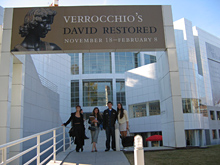
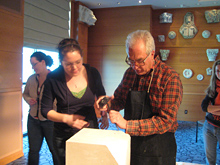
Experiencing art: above, Art History students on a field trip to the High Museum of Art; below, students in a seminar on Roman sculpture observe Peter Rockwell, master stone carver, who was in residency at the Carlos Museum during the spring semester.
Courtesy the Department of Art History.
Art History
Who’s in charge: Judith Rohrer, department chair
When it began: 1965
How many faculty: 12 full-time, plus a number of temporary and adjunct appointments
How many majors: 114; 19 are double majors with visual arts, and 5 are double majors with history Minors: 11; 16 architectural studies minors; 27 visual arts minors
Most important courses required for majors: Majors are required to take courses distributed over four areas of art history, including at least one course in non-Western art; and at least one studio course in the Visual Arts program. The department works closely with the Carlos Museum and offers a course in the conservation of art objects, as well as an interdisciplinary course in physics and art
What’s special about the faculty: “Our faculty tend to be interdisciplinary in their approaches to art objects and constructed space, working with a variety of programs and departments across campus. Several have curated important art exhibitions and work closely with the collections of the Carlos Museum, the High, and other museums nationally and internationally. With three faculty members, the program is particularly strong in the study of architecture.”—Judith Rohrer
What students love: Small class sizes that allow for easy interaction with the faculty and myriad opportunities to travel to art exhibitions and collections
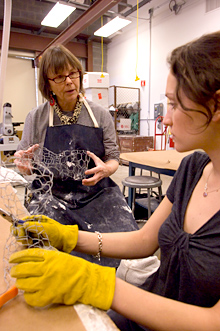
The recently expanded Visual Arts Building, with its 1,100-square-foot gallery devoted to contemporary art installations, is open to students 24/7. Director Linda Armstrong works with a sculpture student.
Kay Hinton
Visual Arts
Who’s in charge: Linda Armstrong, program director
When it began: Visual arts courses have been taught at Emory College since 1967 as part of the art history curriculum; a minor was created in 1992
How many faculty: 5 full-time and 3 to 6 part-time faculty each academic year. The program is currently seeking a full-time, tenure-track professor to oversee photography
How many majors: 17 art history/visual arts joint majors Minors: 27
Subspecialties? Drawing, painting, ceramics, film/video, photography, sculpture
Most challenging course required for majors: Art History 490, a senior seminar required of all art history/visual arts joint majors, in which students must develop a body of work in preparation for a year-end exhibition in the Emory Visual Arts Gallery. First, there is the challenge of establishing and executing the work, then the stressful prospect of putting the work up for critique by their fellow students and faculty, followed by the adaptation of the work within the limits of available exhibition space and the practicalities of displaying the work for the public
What’s special about the faculty: All are working artists who exhibit regularly both within and outside the Atlanta area. Faculty are required to have substantial reputations as artists and solid exhibition histories, allowing students to interact directly with artists who can share both their practical and aesthetic experiences in the art world
What students love: “Our students love the intimate class settings—no class is more than 12 students—and the individualized attention they receive from faculty.”—Linda Armstrong